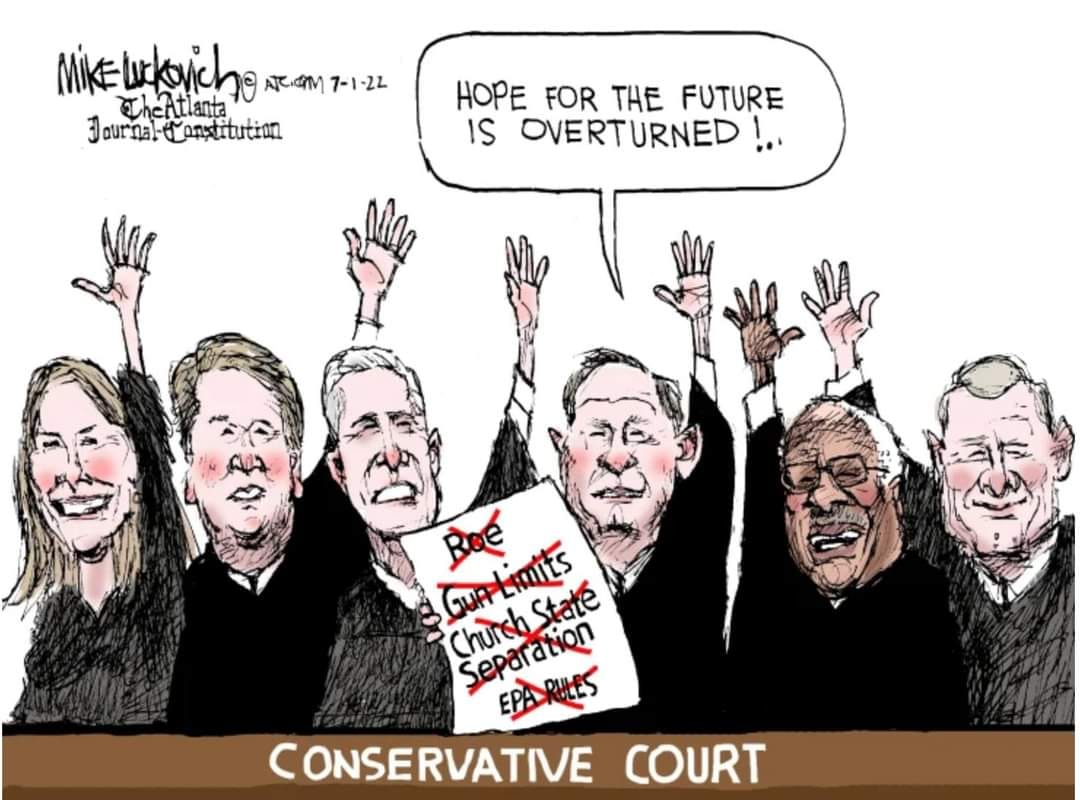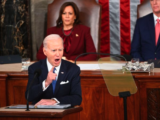Is this the fatal blow in law that will doom human life on planet Earth? –
The Big Picture –
By Glynn Wilson –
Since it is now plainly obvious that the conservative majority on this Supreme Court is packed with biased, politically partisan, “activist judges” who have demonstrated that they feel unbound in their power to abuse their authority to try to dismantle the “administrative state” of the United States of America, it seems reasonable that as an educated, scientifically objective reporter, writer and yes journalist, henceforth the majority opinion MUST be dismissed, leaving the only way to cover this court to rely on the minority dissenting opinions.
There is a long history of this anyway, relying on the minority opinion when the court gets politically out of whack like this one is today.
That is the only vehicle left to the press and the people to find out the facts about how and why the court is ruling the way it is, as I noted in my recent analysis of the Supreme Court ruling in Dobbs v. Jackson. That’s the abortion case in Mississippi in which the court, by a vote of 6-3, overturned 50 years of established law and tossed aside Roe v. Wade and women’s rights of due process and equal protection of the law like a pauper slave tossed out into the streets of London before there was a U.S. of A.
Related: Supreme Court Dismantles Liberty, Rights and Freedoms, and Not Just for Women
As Justice Stephen Breyer noted in that case, arguing that this court is opening the door to striking down more of our rights: “More will follow.”
It has already come to pass.
It may not be noticed or noted by the daily press working on deadline, or highlighted by the talk show host talking heads on broadcast or cable television, or anyone making memes on Facebook. But there is a brief explanation for what’s going on with this court in the most recent dissent in the case of West Virginia v. Environmental Protection Agency.
Way down in the decision, where most reporters don’t have time to go, writing for the minority Justice Elena Kagan drops this line in like a time bomb.
“That anti-administrative-state stance shows up in the majority opinion, and it suffuses the concurrence.”
In case you are not familiar with anti-statism philosophy, even the most simple definition from Wikipedia will do here for a common sense understanding.
“An anti-statist is one who opposes intervention by the state into personal, social and economic affairs. In anarchism, this is characterized by a complete rejection of all involuntary hierarchical rulership.”
So when it suits its purpose to protect Big Business, this court will side with the anarchists in Spain, and the Marxists in France.
Of course in the case of these activist judges, that’s only in regards to this federal government on certain political issues, for these justices proved they side with state power when it is in the hands of anti-statist Republican controlled states. It’s fine if states interfere in the personal lives of women and stomp on their civil liberties, even approving locking them up in prison for daring to have an abortion, as long as it’s not the fedral govm’t telling men with guns what to do.
Covering this case in the national newspaper of record, The New York Times wrote that “the Supreme Court’s conservative majority, with its 6-3 ruling in the case of West Virginia v. Environmental Protection Agency, curtailed the power of the agency to protect the environment, and specifically to require the reductions in emissions that are urgently necessary to limit global warming. The court’s ruling constrains any effort to tighten restrictions on carbon dioxide emissions from power plants.
“It also threatens the Biden administration’s ability to impose new limits on tailpipe emissions from cars and trucks and on methane emissions from oil and gas facilities. As the three members of the court’s liberal minority wrote in a stinging dissent, the majority’s decision strips the E.P.A. of the power ‘to respond to the most pressing environmental challenge of our time’.”
The Supreme Court Sabotages Efforts to Protect Public Health and Safety
That’s from the opening line in Kagan’s dissent. She was joined by Justices Stephen Breyer and Sonia Sotomayor. Here’s a justice writing a summary that any person with common sense who pays any attention to factual news should be able to understand.
“Climate change’s causes and dangers are no longer subject to serious doubt,” she wrote. “Modern science is ‘unequivocal that human influence’—in particular, the emission of greenhouse gases like carbon dioxide—’has warmed the atmosphere, ocean and land,” she said, citing the Intergovernmental Panel on Climate Change. “The Earth is now warmer than at any time ‘in the history of modern civilization,’ with the six warmest years on record all occurring in the last decade.”
“The rise in temperatures brings with it ‘increases in heat-related deaths’,” she says, citing other scientifically accepted reports, along with ‘coastal inundation and erosion,’ ‘more frequent and intense hurricanes, floods, and other extreme weather events,’ ‘drought,’ ‘destruction of ecosystems,’ and ‘potentially significant disruptions of food production’.”
“If the current rate of emissions continues, children born this year could live to see parts of the Eastern seaboard swallowed by the ocean,” she writes. “Rising waters, scorching heat, and other severe weather conditions could force ‘mass migration events[,] political crises, civil unrest,’ and ‘even state failure’,” she argues, citing a climate risk analysis by the U.S. Department of Defense.
”And by the end of this century, climate change could be the cause of ‘4.6 million excess yearly deaths’.”
The majority of the court is clearly unmoved by these scientific facts, and adheres to a Trumpian view that “global warming and climate change are a hoax,” or at least that there is nothing we can do about it so we might as well keep letting the oil and power company executives get even richer while they still can.
And in spite of what the majority tries to argue is an “overreach” by the Environmental Protection Agency beyond what Congress authorized it to regulate in the Clean Air Act and other duly passed laws, she argues, “Congress charged EPA with addressing those potentially catastrophic harms, including through regulation of fossil fuel-fired power plants. Section 111 of the Clean Air Act directs EPA to regulate stationary sources of any substance that ’causes, or contributes significantly to, air pollution’ and that ‘may reasonably be anticipated to endanger public health or welfare’. Carbon dioxide and other greenhouse gases fit that description. EPA thus serves as the Nation’s ‘primary regulator of greenhouse gas emissions’.”
“And among the most significant of the entities it regulates are fossil-fuel-fired (mainly coal- and natural-gas-fired) power plants,” she continues. “Today, those electricity-producing plants are responsible for about one quarter of the Nation’s greenhouse gas emissions. Curbing that output is a necessary part of any effective approach for addressing climate change.
“To carry out its Section 111 responsibility, EPA issued the Clean Power Plan in 2015. The premise of the Plan— which no one really disputes—was that operational improvements at the individual-plant level would either ‘lead to only small emission reductions’ or would cost far more than a readily available regulatory alternative.”
She goes on to explain to the majority what terms like “generation shifting” mean, ways of shifting electricity generation from higher emitting sources to lower emitting ones — from coal-fired to natural-gas-fired sources, and from both to renewable sources like solar and wind.
The majority scoffs at such terms, and one can see Clarence Thomas glaring askance in the opinion here, taking a cue from his wife Ginny’s favorite insurrectionist president.
“This Court has obstructed EPA’s effort from the beginning,” she writes. “Right after the Obama administration issued the Clean Power Plan, the Court stayed its implementation.
“That action was unprecedented: Never before had the Court stayed a regulation then under review in the lower courts.”
The effect of the Court’s order, followed by the Trump administration’s repeal of the rule, she says, was that the Clean Power Plan never went into effect. The Plan’s moderation was proved in the years since anyway, she says, by “market forces,” when the power industry met the Plan’s nationwide emissions target, “through exactly the kinds of generation shifting the Plan contemplated.”
By the time yet another President took office, she says, “the Plan had become, as a practical matter, obsolete.”
For that reason, the Biden administration announced that, instead of putting the Plan into effect, it would commence a new rule-making.
“Yet this Court determined to pronounce on the legality of the old rule anyway,” she writes. “The Court may be right that doing so does not violate Article III mootness rules (which are notoriously strict). But the Court’s docket is discretionary, and because no one is now subject to the Clean Power Plan’s terms, there was no reason to reach out to decide this case. The Court today issues what is really an advisory opinion on the proper scope of the new rule EPA is considering. That new rule will be subject anyway to immediate, pre-enforcement judicial review. But this Court could not wait—even to see what the new rule says—to constrain EPA’s efforts to address climate change.”
“The limits the majority now puts on EPA’s authority fly in the face of the statute Congress wrote. The majority says it is simply ‘not plausible’ that Congress enabled EPA to regulate power plants’ emissions through generation shifting,” she concludes. “But that is just what Congress did when it broadly authorized EPA in Section 111 to select the ‘best system of emission reduction for power plants.”
The majority’s decision rests on one claim alone she says: “that generation shifting is just too new and too big a deal for Congress to have authorized it in Section 111’s general terms. But that is wrong.”
A key reason Congress makes broad delegations like Section 111 is so an agency can respond, appropriately and commensurately, to new and big problems, she reasons.
“Congress knows what it doesn’t and can’t know when it drafts a statute; and Congress therefore gives an expert agency the power to address issues—even significant ones—as and when they arise. That is what Congress did in enacting Section 111.
“The majority today overrides that legislative choice. In so doing, it deprives EPA of the power needed — and the power granted — to curb the emission of greenhouse gases.”
The Clean Air Act was major legislation, she points out (passed under a Republican president, Nixon, and a Republican Congress) “designed to deal with a major public policy issue,” she says. “As Congress explained, its goal was to ‘speed up, expand, and intensify the war against air pollution’ in all its forms.”
The New York Times focuses it’s analysis on the dilemma for the Biden administration, which is already struggling to persuade Congress to invest in renewable energy, compelled by Russia’s invasion of Ukraine to push for increased production of oil and gas here, and “once again finds its ambitious goals for confronting climate change slipping beyond reach.”
“The court’s adversarial posture means that the administration must double down on its efforts to win congressional support for its spending plans,” the Times advises, and “President Biden and Democratic leaders should also press to pass legislation clarifying the E.P.A.’s authority to regulate emissions.”
The paper of record’s editorial board also said the ruling has consequences far beyond environmental regulation.
“It threatens the ability of federal agencies to issue rules of any kind, including the regulations that ensure the safety of food, medicines and other consumer products, that protect workers from injuries and that prevent financial panics.”
“The decision amounts to a warning shot across the bow of the administrative state,” the Times says. “The court’s current conservative majority, engaged in a counterrevolution against the norms of American society, is seeking to curtail the efforts of federal regulators to protect the public’s health and safety. The court already invoked a similar logic during the Covid pandemic to strike down workplace Covid testing requirements and a federal moratorium on evictions.
“And by refraining from defining a threshold for what constitutes a ‘major question,’ the court is leaving a sword hanging over every new rule.”
In her dissent, Kagan points out the sarcastic and ill-informed language in the majority opinion, supposedly written by Chief Justice John Roberts with a little help from his minions on the right like Thomas, Alito, and pro-big business Neil Gorsuch, when they call Section 111(d) a “gap-filler.”
“It might also be thought of as a backstop or catch-all provision, protecting against pollutants that the NAAQS and HAP programs let go by. But the section is not, as the majority further claims, an ‘ancillary provision’ or a statutory ‘backwater’,” she argues. “That characterization is a non-sequitur.”
“Section 111(d) tells EPA that when a pollutant—like carbon dioxide—is not regulated through other programs, EPA must undertake a further regulatory effort to control that substance’s emission from existing stationary sources,” she explains to the dunderheads in the majority. “In that way, Section 111(d) operates to ensure that the Act achieves comprehensive pollution control.”
The majority seems to have trouble for its part in understanding the meaning of what a “system” is, or maybe they just don’t like systems, especially if they regulate pollution derived from commerce. So Justice Kagan helps them out.
“A ‘system’ is ‘[a]n organized and coordinated method; a procedure’,” she says, using the definition from Webster’s Third New International Dictionary.
In trying to make the case against such a “vague” thing in federal law, the majority says: “[A]lmost anything” capable of reducing emissions ‘could constitute such a ‘system’ of emission reduction.”
As if that was a bad thing.
“But that is rather the point,” Kagan argues. “Congress used an obviously broad word (though surrounding it with constraints, citation) to give EPA lots of latitude in deciding how to set emissions limits. And contra the majority, a broad term is not the same thing as a ‘vague’ one. A broad term is comprehensive, extensive, wide-ranging; a ‘vague’ term is unclear, ambiguous, hazy. (Once again, dictionaries would tell the tale.) So EPA was quite right in stating in the Clean Power Plan that the “[p]lain meaning” of the term “system” in Section 111 refers to “a set of measures that work together to reduce emissions.”
Duh.
She is not done with school.
“Another of this Court’s opinions, involving a matter other than the bogeyman of environmental regulation, might have stopped there,” she says. “For generation shifting fits comfortably within the conventional meaning of a ‘system of emission reduction.’ Consider one of the most common mechanisms of generation shifting: the use of a cap-and-trade scheme.”
Here is how the majority describes cap and trade: “Under such a SCHEME (emphasis added), sources that receive a reduction in their emissions can sell a credit representing the value of that reduction to others, who are able to count it toward their own applicable emissions caps.”
“Does that sound like a ‘system’ to you? It does to me too,” she says, apparently talking to the American people. “And it also has to this Court. In the past, we have explained that ‘[t]his type of “cap-and-trade” system cuts costs while still reducing pollution to target levels.”
She goes on, and takes on the majority’s apparent hatred of anything to do with “technology,” along with any kind of federal regulations, especially when it concerns the EPA.
“The Clean Power Plan falls within EPA’s wheelhouse, and it fits perfectly—as I’ve just shown—with all the Clean Air Act’s provisions,” Kagan argues. “That the Plan addresses major issues of public policy does not upend the analysis. Congress wanted EPA to do just that.”
She even cites arch conservative Justice Antonin Scalia at one point to try to get these new Trump appointed justices to understand that the court has a long history of treading lightly and “modestly” when over ruling decisions by executive branch agencies empowered by Congress to “regulate” things it does not have the expertise to oversee itself.
She makes it clear that the majority has no idea how the electricity market works.
In a tragically humorous bit near the end, she admits to being wrong when she made a speech in recent years saying, “We’re all textualists now.”
Textualism is a mode of legal interpretation that focuses on the plain meaning of the text of a legal document. Textualism usually emphasizes how the terms in the Constitution would be understood by people at the time they were ratified, as well as the context in which those terms appear.
Some years ago, I remarked that “[w]e’re all textualists now,” she says.
“It seems I was wrong,” Kagan concludes. “The current Court is textualist only when being so suits it.”
“Today, one of those broader goals (of this court) makes itself clear,” she says. “Prevent agencies from doing important work, even though that is what Congress directed.
“That anti-administrative-state stance shows up in the majority opinion, and it suffuses the concurrence.”
She is pointing out this obvious bias on the part of the justices now in the majority. They are clearly anti-federal government, don’t much like Congress or the executive branch agencies. But they would apparently like to see a dictator president in charge of the executive branch, as long as he is a conservative willing to overthrow democracy itself.
When it comes to delegating authority to federal agencies, there are good reasons for Congress to do it, she argues.
“Congress knows about how government works in ways courts don’t. More specifically, Congress knows what mix of legislative and administrative action conduces to good policy,” she concludes. “Courts should be modest.
“Today, the Court is not,” she declares, in effect calling them “activist judges.”
Section 111, most naturally read, authorizes EPA to develop the Clean Power Plan—in other words, to decide that generation shifting is the “best system of emission reduction” for power plants churning out carbon dioxide,” she says. “Evaluating systems of emission reduction is what EPA does. And nothing in the rest of the Clean Air Act, or any other statute, suggests that Congress did not mean for the delegation it wrote to go as far as the text says.
“In rewriting that text,” she continues, “the Court substitutes its own ideas about delegations for Congress’s. And that means the Court substitutes its own ideas about policymaking for Congress’s. The Court will not allow the Clean Air Act to work as Congress instructed. The Court, rather than Congress, will decide how much regulation is too much.
“The subject matter of the regulation here makes the Court’s intervention all the more troubling,” she worries. “Whatever else this Court may know about, it does not have a clue about how to address climate change. And let’s say the obvious: The stakes here are high.
“Yet the Court today prevents congressionally authorized agency action to curb power plants’ carbon dioxide emissions,” she concludes.
“The Court appoints itself—instead of Congress or the expert agency—the decision maker on climate policy. I cannot think of many things more frightening. Respectfully, I dissent.”
Read the full decision and the dissent here
___
If you support truth in reporting with no paywall, and fearless writing with no popup ads or sponsored content, consider making a contribution today with GoFundMe or Patreon or PayPal.
Before you continue, I’d like to ask if you could support our independent journalism as we head into one of the most critical news periods of our time in 2024.
The New American Journal is deeply dedicated to uncovering the escalating threats to our democracy and holding those in power accountable. With a turbulent presidential race and the possibility of an even more extreme Trump presidency on the horizon, the need for independent, credible journalism that emphasizes the importance of the upcoming election for our nation and planet has never been greater.
However, a small group of billionaire owners control a significant portion of the information that reaches the public. We are different. We don’t have a billionaire owner or shareholders. Our journalism is created to serve the public interest, not to generate profit. Unlike much of the U.S. media, which often falls into the trap of false equivalence in the name of neutrality, we strive to highlight the lies of powerful individuals and institutions, showing how misinformation and demagoguery can harm democracy.
Our journalists provide context, investigate, and bring to light the critical stories of our time, from election integrity threats to the worsening climate crisis and complex international conflicts. As a news organization with a strong voice, we offer a unique, outsider perspective that is often missing in American media.
Thanks to our unique reader-supported model, you can access the New American journal without encountering a paywall. This is possible because of readers like you. Your support keeps us independent, free from external influences, and accessible to everyone, regardless of their ability to pay for news.
Please help if you can.
American journalists need your help more than ever as forces amass against the free press and democracy itself. We must not let the crypto-fascists and the AI bots take over.
See the latest GoFundMe campaign here or click on this image.
Don't forget to listen to the new song and video.
Just because we are not featured on cable TV news talk shows, or TikTok videos, does not mean we are not getting out there in search engines and social media sites. We consistently get over a million hits a month.
Click to Advertise Here


















Really scary …
Thank you for such an informative piece.
Sad n scarry stuff goin on now! Thanks 4 your time and writing skilks, appreciate it!